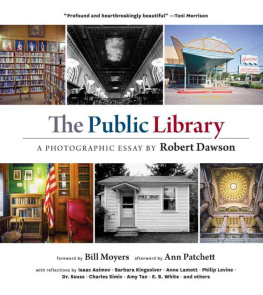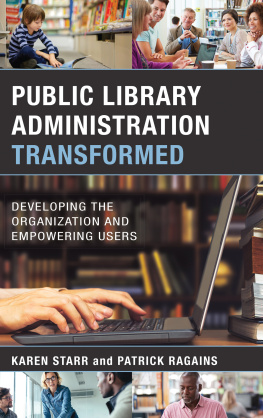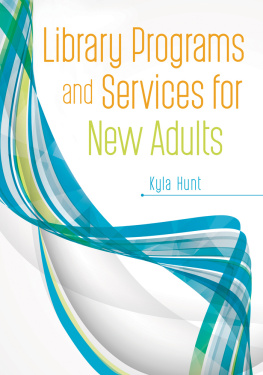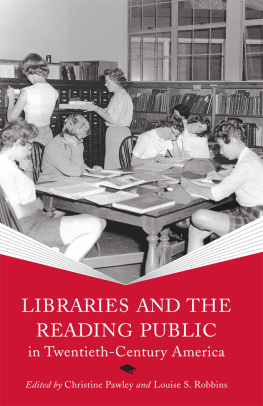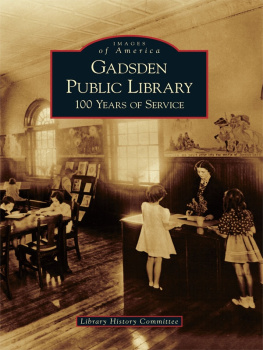
Reading room, Stephen A. Schwarzman Building, New York Public Library, New York, New York, 2008 | Often referred to as the main branch, this Beaux-Arts landmark was initially formed from the consolidation of the Astor and Lenox Libraries and has evolved into one of the worlds preeminent public libraries. It houses some fifteen million items, including priceless medieval manuscripts, maps, and contemporary novels and poetry, as well as baseball cards, dime novels, and comic books. More than twelve hundred languages and dialects, ancient and modern, are represented in the collections, emblematic of the rich diversity of the city that built it.

Published by
Princeton Architectural Press
37 East Seventh Street
New York, New York 10003
Visit our website at www.papress.com
2014 Robert Dawson
All rights reserved
Printed and bound in China by C&C Joint Printing Co.
17 16 15 14 4 3 2 1 First edition
No part of this book may be used or reproduced in any manner without written permission from the publisher, except in the context of reviews.
Every reasonable attempt has been made to identify owners of copyright. Errors or omissions will be corrected in subsequent editions.
Editors: Sara Stemen and Sara Bader
Designer: Paul Wagner
Special thanks to:
Meredith Baber, Nicola Bednarek Brower, Janet Behning, Megan Carey, Carina Cha, Andrea Chlad, Barbara Darko, Benjamin English, Russell Fernandez, Will Foster, Jan Hartman, Jan Haux, Diane Levinson, Jennifer Lippert, Katharine Myers, Lauren Palmer, Jay Sacher, Rob Shaeffer, Andrew Stepanian, and Joseph Weston of Princeton Architectural Press
Kevin C. Lippert, publisher
GRAHAM FOUNDATION
This project was supported by a generous grant from the Graham Foundation for Advanced Studies in the Fine Arts.
Library of Congress Cataloging-in-Publication Data
The public library : a photographic essay / Robert Dawson ; foreword by Bill Moyers ; afterword by Ann Patchett. First edition.
pages cm
Includes essays, letters, and poetry by a collection of American writers and librarians.
ISBN 978-1-61689-217-3 (hardback)
1. Public librariesUnited StatesPictorial works. 2. Public librariesUnited States. 3. Libraries and societyUnited States. 4. Libraries and communityUnited States. 5. Library usersUnited States.
I. Dawson, Robert, 1950 Photographs. Selections.
Z731.P9265 2014
027.70973dc23
2013026827
CONTENTS
FOREWORD BILL MOYERS
I n a file next to my desk, I have kept for fifteen years a now-yellowed clipping from the weekly newspaper in the small town in New Jersey where we live. The headline reads: LIBRARY WAS TOP BERNARDSVILLE STORY IN 98. Yes, the biggest news of the year was the construction of a municipal library in the center of town at a cost of almost $5 million. I have kept the story because as a citizen and journalist, I never want to forget what really mattersand the local library matters.
Fast-forward to 2011. We were hit hard by the Halloween snowstorm that knocked out power over a wide area of central New Jersey. The next daya cold and dark Sundayour library became a refuge to nearly one thousand people who warmed themselves, recharged their technological and personal batteries, and discovered camaraderie born of adversity. The library mattered for reasons we had not anticipated.
The library mattered, too, in the small Texas town where I grew up. Lady Bird Johnson and I once served as cochairs of the campaign to build it. Long before she became Mrs. Lyndon B. Johnson and Americas first lady, she had graduated from high school there, as I would later. She liked to recall that in her time, the municipal library consisted of a modest collection of randomly donated books stored in a cramped and darkly lit space under the stairs in the county courthouse. By the time I came along, a group of business-women had managed to acquire a lovely Georgian building between the business district and the First Baptist Church and turn it into a free library that became a mecca for poor kids like me. There, at the age of eleven or twelve, I entered a boundless world to discover more lives to lead than I had dreamed of. In books plucked from the shelves were stories that I have never forgotten: explorers whose adventures I could envy, heroes whose exploits I could admire, villains I could hiss.
I still remember the first two books I took home: Jules Vernes Around the World in Eighty Days and a popular version of ancient Greek and Roman myths whose title now escapes me. I do not know why I chose those two, but when I won third prize in a tenth-grade poetry contest with a pretentious little lyric entitled I Have Seen Rome, some classmates ribbed me about how I could possibly know of Colosseums and catacombs and caesars in togas. I knew how: the Appian Way began for me on East Burleson Street in that small Texas town. Years later, when I visited Rome as a graduate student, I was struck by how familiar it seemed, although I had never been there. Samuel Beckett was right: when we are reading, a voice comes to us as in the dark and whispers, Imagine!
Of course, books and reading, periodicals and references no longer exhaust the definition of a library. The one in the town where I live is a beehive of activity. The year of the storm, there were 200,046 visits, an average of 25 per resident; 161,945 people used the website; 78,870 accessed its computers; 14,384 children attended story time, and the library conducted a tech update on cloud storage, a session on how citizens could protect against financial fraud, a screening of the documentary Forks Over Knives (the film Roger Ebert said could save your life), an art exhibit, book discussions, and a Sunday jazz concert, among many other eventsall for a base budget of just one million dollars.
Libraries come in all shapes and sizes, as Robert Dawson stunningly reminds us in this collection of photographs. He takes us to different places and different libraries, one by one, for a glimpse into what he aptly calls a vibrant, essential, yet threatened system that has contributed immeasurably to the fiber and fabric of our democracy.
In these pages you will travel through America, past and present, from the grandeur of the reading room in the main library in New York City to the layered Victorian solidity of the Willard Library in Evansville, Indiana, from the spare, trailer-like library in Death Valley National Park to the Star Treklike gleaming latticed wonder of the central library in Seattle, Washington. You will quickly realize the pleasures of a journey across a vital commons of the American experience in the company of an accomplished artist whose work has graced the Museum of Modern Art in New York, the J. Paul Getty Museum in Los Angeles, and the Library of Congress in Washington, D.C.
Open the book to . You are now on the ground floor of the library in Midland, Texasfar out on the plains of the Lone Star State. Look to the left. There in the corner you will see a room marked Children. Now look to your right: a solitary young man, attired in a T-shirt, shorts, and sandals, sits intently engaged. Let your eyes follow the stairs upward. Notice the directions to the left: Nonfiction/Reading Room/Reference. To the right: Business/Meeting Room/Periodicals. The photograph is memorably framed to reveal converging worlds beneath a single roof.
Now turn to you will come to the library in Mississippi named for Fannie Lou Hamer, the ejected tenant farmer who refused to be intimidated and became a heroine of the civil rights movement.
Next page
